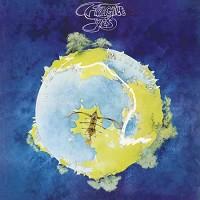A Drifting Group Tries to Keep it Together
For my money, the greatest YES album, musically and sonically was 1971’s The Yes Album (Atlantic SD 8283), recorded Autumn of 1970, and if you can find an original, thick “1841 Broadway” pressing, get one. An audiophile-quality reissue generated from the master tape would be nice, but unfortunately, Rhino took it upon itself to reissue it recently in their first, undistinguished entry into vinyl, and it wasn’t very good.
Since that first bus plunge, wiser heads have prevailed and Rhino now lets “outsiders” like Kevin Gray and Steve Hoffman and Stan Ricker do the cutting. These guys are far better suited to the job than the anonymous cutting engineer at Capitol who mastered that sonically forgettable YES reissue.
Fragile, recorded late summer of 1971, at the same Advision studio as The Yes Album and issued as Atlantic SD 7911, found the group’s cohesiveness in a “fragile” state, though I’m not sure it was to that that the title refers.
However, once you start breaking an album apart into “solo” projects as this one does, you’re looking for trouble, and in my opinion, the group found it with the disjointed Fragile, though of course it does contain some solid work, including “Round-about,” “Long Distance” and especially the dramatic collaborative effort “Heart of the Sunrise.”
In 1971 we could have done without Wakeman’s stiff Brahms synth transcription (Wendy Carlos did this sort of thing much better years earlier) and in 2007 we need it even less. If you’re not into classical music and think this is swell but have never heard the real thing, get yourself a “6 Eye” original Bruno Walter reading of the Brahms 4th and start with the 3rd movement. You may be converted.
In any case, no one doubts the virtuosic talents of this group’s individual members. It’s just that they work and play so much better together and Howe’s live “The Clap” on The Yes Album was sufficient for us to admire his playing. Howe’s Spanish-styled “Mood For a Day” also showcases his technical abilities but it also points out that he’s compositionally derivative and kind of weak. But why flog a 35 year old horse?
The bottom line is, you’re buying this because you already like it and want to hear it better than you already have. If you’ve only heard this as a CD or god forbid as an MP3 file, this reissue will be a revelation.
But here’s the deal: this was never a very good recording to begin with. I don’t know what happened to Offord and Advision studio between the sonic grandeur of The Yes Album and this cardboardy, compressed and somewhat cloudy and distant affair, but something and not the original or new mastering engineers are to blame. Perhaps they “upgraded” to a newfangled solid-state board? Whatever happened, the drum recording is flat and dry, with the bass drum sounding like a rubber toy and cymbals devoid of air and shimmer. If you listen to the depth of the bass and the stentorian dynamic swings found on The Yes Album, you’ll exclaim “What the fuck?” as I did back in 1971 when I plopped the original Fragile on my Dual 1219.
So Gray and Hoffman didn’t have a silk purse to worth with and while they didn’t turn a sow’s ear into one, they did the best they could, making some smart mastering choices along the way.
But first, here’s something interesting: my original has both George Piros’s “GP” in the “dead wax” and a “PORKY”!!!!!! So the original side one was cut in the UK by George Peckham (unless he flew to New York and collaborated with Piros, which I doubt), and the lacquer flown to New York for Piros to scribe and plate. Side two has no “PORKY” (or "Porky Prime Cut" or "Pecko Duck") so either he didn’t mark it (unusual), or side two is a Piros cut. Whatever, and whoever, there just wasn’t that much to work with.
Gray and Hoffman avoided the trap of excessively boosting the bottom end in a vain attempt to add what’s not there, and they also avoided lifting the top to also try and add what’s not there. Instead, they concentrated in the middle, where they finessed the rich textures that were on the tape.
So when you hear the opening “pling” of “Roundabout,” you’ll hear it with a velvety-richness missing on the original, though the original’s top end extension and transient sharpness is somewhat better. Look, the tape is more than 35 years old!
Combine the midband richness, improved overall transparency and eerily black backgrounds and one has to declare this reissue a complete success, though the packaging, while good, is not quite up there with the best reissues. Why? While AP did do paper over cardboard, which is the right way to go, Roger Dean’s cover art is reproduced with a bit too much contrast, obscuring detail. Also, the inner jacket’s grey textured matte paper has been replaced with plain glossy white and the enclosed booklet has also been reproduced on a glossy not matte paper stock. I supposed purists would have also preferred the original Atlantic logo instead of Analogue Production’s silver/black one.
However, these are minor quibbles. The more I listen to this, the more I appreciate the mastering. On “Heart of the Sunrise” at least, perhaps Gray/Hoffman have turned a sow’s ear into a silk purse! And props to Rick Wakeman for being the first DWEEB to thank 100 or so friends and family on an album. He set the standard for one of the most annoying “traditions” in pop music. At least he didn’t thank the invisible man in the sky!



